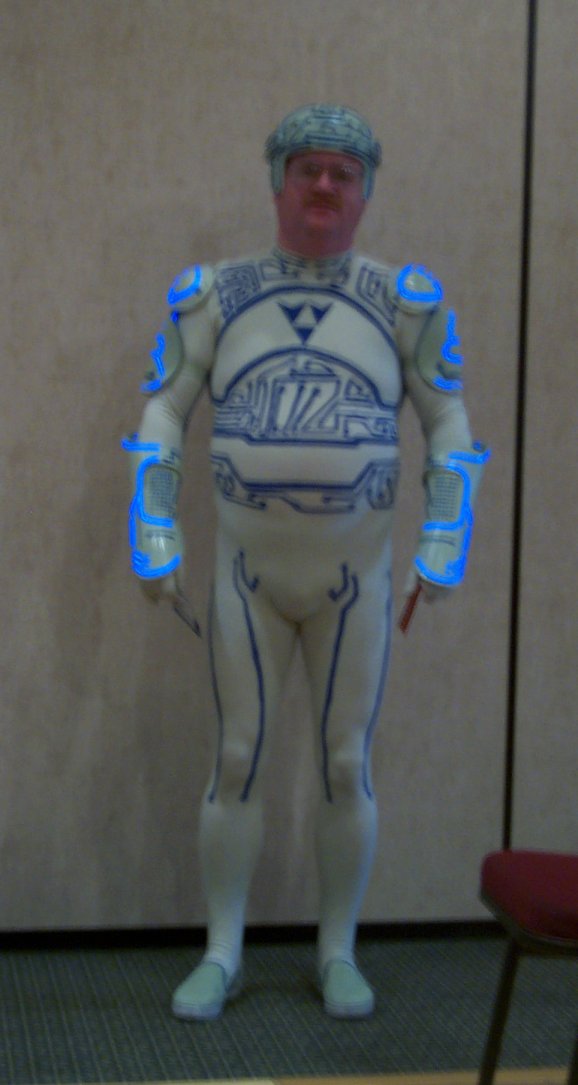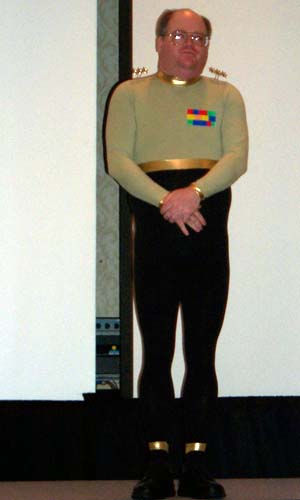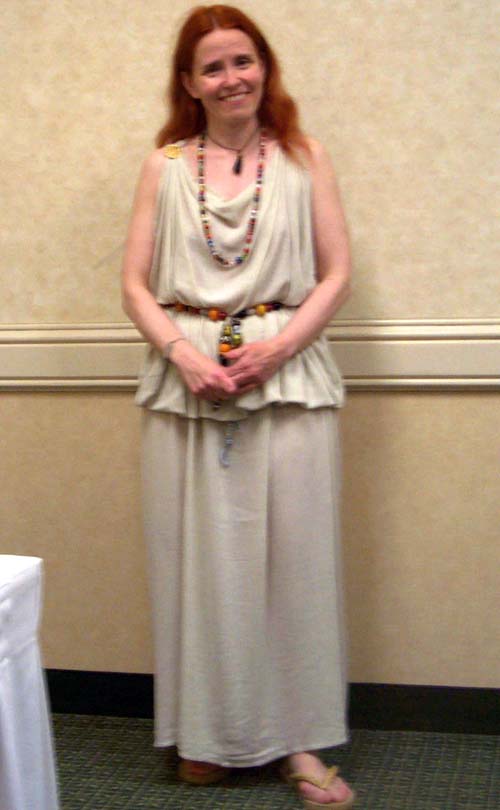Costuming 101: a panel at Linucon 2004
Synopsis from Linucon program book: Wanting to build a costume? Grab a seat for some tips and tricks from those who know.
Panelists: Kim Kofmel, Jay Maynard, Cathy Raymond
There are several ways you can win a costume award at a masquerade. By making audience laugh, for example. By being original. There is also a fairly self-explanatory “workmanship” category. This panel devoted quite a bit of space to the tips and tricks of how to make a costume, and they managed to be quite entertaining while doing that. Far from being tedious, their discussion was enlivened with all kinds of titillating details from the costume history. The panelists also spoke about the psychology of wearing a costume, and the motivation for making one in the first place. All in all, an interesting panel even for those who, like myself, have only a marginal interest in costuming.
Linucon was a joint science fiction and Linux convention. It took place in October 2004 in Austin, TX. The most prominent guests was Eric Raymond and Jay Maynard, a.k.a The Tron Guy.
Kim Kofmel. Workmanship is one of the most stressful categories to compete in, because judges get really close to you. As a judge she herself had lifted other people’s skirts and checked their hoops. It’s pretty up-close and personal.
Cathy Raymond (who is the spouse of the Linucon guest Eric Raymond). “If you are dressed in a Victorian costume, your underwear is necessarily a part of the costume. Without the right underwear, it’s not right for Victorian. On the other hand, if you’re wearing spandex, they probably aren’t going to need to look under your spandex.”
Kim. “Same is you are wearing two pieces of chain mail held together by duct tape.”
Which brings up the “no costume is no costume” rule. It is a twofold rule, says Kim, though both of its aspects can’t be summed up as “if you’re not wearing an actual costume, then what’s the point?” First, if you are naked, that’s not a costume. (Apparently this has happened at some masquerades, otherwise would there be a rule?) You better make a very good point with your body paint. Or you can — Kim reminisces — put together a bone bikini. There was one at a Toronto convention years ago. It was made of bone and leather and prominently featured two animal skulls (real animal skulls) over the wearer’s frontal assets. It became a minor legend.
Why do people make costumes?
Cathy does it because she is interested in history; in particular she would like to get her mind around the idea of what it must have been like. “There aren’t many ways people in our day and age can experience that, but one of the ways is by wearing clothing of that period. You move differently in a corset and a hoop skirt than you do in a t-shirt and jeans. Doing that much may give you a better idea of what life in the Victorian age was like, than reading the books about it.”
What attracts Kim to costuming is that she is fascinated by how we use clothing to project identity, and how different clothing allows us to transform ourselves.
Cathy’s interest in costuming was also fueled by her involvement in live role-playing games. At one convention years ago she played a mad scientist’s lab assistant in a LARP. She was dressed in a sexy costume of tight sweater, wonderbra, short skirt, fishnet stockings and heels. When she took a break from the game and wondered into a room party, even a good friend of hers didn’t recognize her.
Jay, on the other hand, has had the opposite experience: due to his television appearances he is mostly recognized when is in costume: “Oh, the Tron guy!” Exactly one person has ever recognized him out of costume.

Kim. Costumes are a lot like puppets. When a puppet is hanging on the wall, it’s just a bunch of rags and some wires. It may have some visual interest, but not a lot. But when a skilled puppeteer makes the puppet move, it’s astonishing to watch. It’s the same with the costume.
Costumes also have a de-inhibiting effect.
Jay. “Wearing this costume, I don’t have the luxury to be self-conscious. I know that upfront, and because of that I feel able to do things I wouldn’t normally consider doing.”
Kim. “I actually got my first boyfriend because I was covered in silver body paint — as you said, because of the de-inhibiting factor. I saw this guy standing in the corner in a party in a convention, and I walked up to him and said “Hi! Wanna smear my body paint?”
They were together for 5 years.
Design the costume around your limitations
A costume should be, errr, tailored to your limitations. If you can’t sew, it’s perfectly possible to make a good costume without sewing. That’s how Jay Maynard made his; he can’t sew. Not to say that it was easy, though — for him the hardest part was to apply fabric paint on spandex. Fabric paint is very unforgiving: you can’t wipe it off fabric like you would wipe off paint of other surfaces. But it must have been worth it: his costume won the workmanship award at Penguicon this year. It won because of all costumes at Penguicon it had the most detailed work and most different types of work on it (the neon tubing, the helmet, the power disk on the back). Nobody else went to the trouble of applying lines of paint on cotton-spandex and getting them straight.
Kim gives another example of a costume that won not despite, but because an unusual application of a technique that doesn’t usually get awarded prizes. “A costume that won the workmanship award at 2004 Worldcon in Toronto was a Godzilla costume. The part that won the award was the mask. It was a gorgeous full head mask, scaly and knobbly and oobly (yes, the adjective Kim used sounded like “oobly”) and it was basically Attack of the Killer Glue Gun. The boy had made this texture on the mask with glue gun. Most of the time we don’t want people to see (traces of the glue gun work), that’s the secret magic that holds it together.”
As an example of designing a costume around your limitations, Kim tells about a teenage boy who incorporated his wheelchair into a Dalak (spelling?) costume. His movements very convincingly portrayed a Dalak. I didn’t know what a Dalak was, so the panelists helpfully explained to me that Dalaks were evil robots from Dr. Who, like R2D2 but a little taller.

Jay says he was told more than once he shouldn’t have done the Tron costume, because a fat guy like he shouldn’t wear spandex. He rejects this comment, yet he agrees with the idea someone else pointed out, that you should wear a character costume as if you were casting yourself in the role of that character. In that case, if your character is overweight when he shouldn’t be, better come up with a story of how your character became overweight. Jay said that the costume he was doing for this convention (not the Tron — he presented a different costume at the masquerade) was chosen specifically to work with his body type. I must say, it wasn’t obvious to me, when I saw his masquerade costume. Perhaps it would have been if I had known the backstory of the character he was portraying. As it is, being a person who doesn’t watch television, I couldn’t even tell what show he came from. Yet Jay assured that those who are familiar with the universe the costume comes from will instantly and 100% recognize the character and Jay’s motivation to play up his body type for this character.
No costume is without mistakes
Mistakes are inevitable when making costumes. What matters, Cathy says, is what you make of them. Just like with cooking, Kim concurs, no one needs to know what a dinner was supposed to be, and no one will know unless you tell them.
Jay demonstrates a glitch in his costume that turned out to be very practical. He accidentally made a hole in the fabric on his chest when trying to cut off the masking tape that he somehow used to apply paint. (Don’t ask me how tape is used in applying paint. It must be too advanced for Costuming 101. 🙂 Or, just as likely, I misunderstood what he said.) The hole turned out to be very handy to thread a wire of a microphone that he used when speaking at public events (the kind of public events where he appears in the Tron costume :-))
And did we mention underwear?
Few panels on a Linux/SF convention are so rife with titillation as a costuming panel. There’s the whole underwear theme. Somewhat out of the blue, Kim asks Cathy if she’s wearing authentic undergarments with her “barbarian woman” costume. Cathy says, strictly speaking no, her panties are modern. As for the bra, the Romans that originated this clothing style, according to Cathy, used to wear a strip of cloth, kind of a bandage around their breasts to provide support. Cathy, however, noticed that the presence or absence of the “bandage” made very little difference on her. So usually she goes without anything of that sort.

Jay. “While we are here, for the sake of completeness, I will point out that men in the Renaissance era wore codpieces on the outside, but did not wear anything on the inside. And some of them didn’t wear anything on the outside either, they just depended on the hose. In fact, there are writings from the era where they discuss the fact that there are men out there with hose and their codpieces and they are visible. Obviously, that’s not going to work in modern times. Modern sensibilities don’t allow it.”
“As it happens”, Jay adds, “those of us who dress in Renaissance era clothing are inaccurate in one other respect. Men of that era would kill for spandex. What they wore instead was just a regular woven fabric cut on the diagonal, so it would have some stretch. It was itchy, it was chafy, it was not all that comfortable.”
Kim. “It bagged. It sagged.”
Jay. “But all the historical paintings from that era don’t show the bags and the sags. They show them as though they were wearing spandex.”
Jay also points out that codpieces were originally used the way we use pouches and purses today. Kim confirms that she had read an article about use of codpieces for carrying coins, candy and stuff. She was reading the article for a school paper. In her original hand-draft of the paper she made a note: “Candy, little girl?”
Underpants, Kim segued, was something that was invented in late middle ages or Renaissance, if not later, and at first were condemned by the Church that thought a fabric touching woman’s legs or her, umm, nether regions, would provoke lascivious thoughts in her. So not wearing underwear used to be thought more “decent” than wearing it! It also meant that if a lady fell from a horse while riding, her charms may be exposed for the whole world to see.
Jay. “Benjamin Franklin, while he was the ambassador in Paris, wrote a letter to somebody here in United States, that he observed a French noblewoman fall over, and noticed that she wasn’t wearing anything, and that everything was open to display at that point.”
Cathy. “While we are on the subject of underwear, this comes back to another practicality. Victorian women did wear kind of underpants, but until very late in the period the seams along the inside of the legs were not sewed up. That was not a bug, that was a feature. When I made myself a US civil war period costume, I thought, OK, how do I go to the bathroom in this? The answer is, you don’t, if you’re wearing conventional underwear (because it is impossible to pull down). But if you have crotchless panties, all you have to do is pull the fabric aside, and get the skirts out of the way.”
So these were some of the more enlightening aspects of Costuming 101.